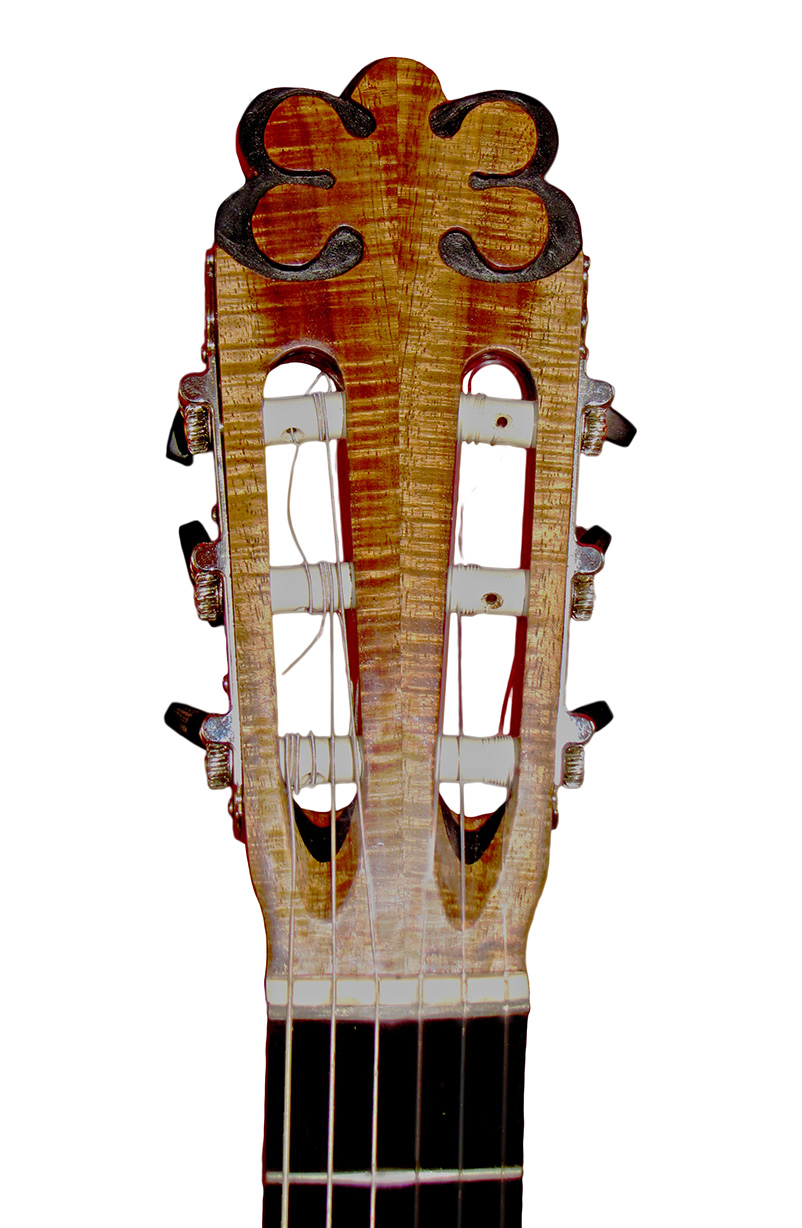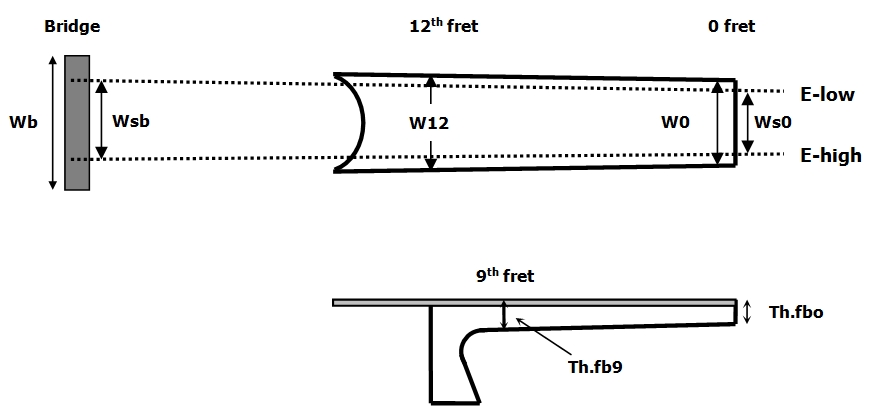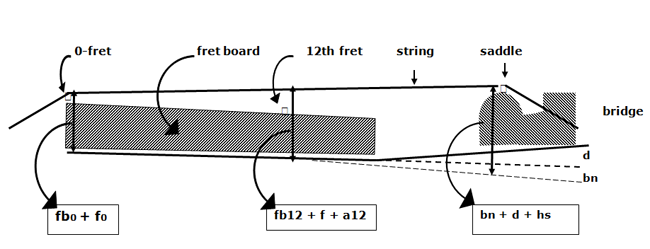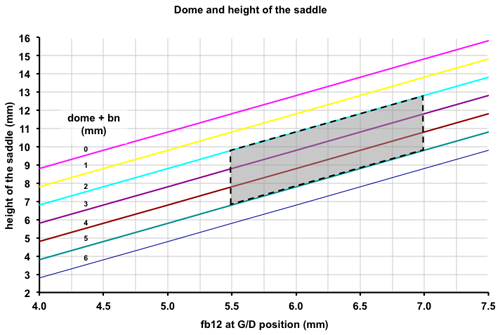5 The neck and head
Dimensions

As explained in chapter Acoustic principles the construction of the neck has to guarantee that under string load the neck deflection will be practically zero. From the standpoint of a design that is based on a connection between nut and saddle firm as a rock the design of the neck itself is relatively simple. If you follow the usual instructions in guitar construction manuals you will end up with a neck that can withstand the pulling forces of the strings without any problem. For an impression of actual deflection it is interesting to look in the appropriate spreadsheets in "Left-Brain-Lutherie" (ref. 15).
For a more or less standard classical guitar neck (mahogany with an ebony fret board) the deflection, measured in change in the action at the 12th fret is about 0.1 mm, which is no problem to deal with during the construction. For the EB-guitars this deflection is even less than 0.05 mm. The choice of the wood and careful construction of the neck and its connections with foot, heel and fret board has to prevent dimensional changes with time. But that is more of a constructional challenge than a design problem.
In order to avoid buzzing of the vibrating strings against the frets we have to provide enough action (distance between the strings and frets). Too much action however hampers the playability and therefore sometimes guitars are provided with a concave fret board. In ref. 13 by Oswald J. Verbeij the author gives theoretical analyses for an optimal finger board curvature. Some of his conclusions were that:
- the optimal fingerboard is slightly concave with positive relief amounting 1/10th of string action at the 6th fret
- the optimal nut (0-fret) height above the first fret is 1/20th of string action
- the action of an optimal concave finger board may be 27% lower compared to an absolute flat one
These findings are applied for the EB-guitars.
In view of the playability the fret board may also be domed perpendicular to the neck. To what extent is up to the choice of the individual player. The fret boards of the EB-guitars described on this web site have a slight dome. At the position of the high and low E-strings the fret board is thinned with ~1.5 mm compared to the middle of the fret board.
In general, the width and thickness of the neck and fingerboard are chosen in view of the playability of the guitar. From that point of view it is interesting to know how some famous luthiers chose these dimensions. In his book "Making Master guitars" (ref. 21) Roy Courtnall gives detailed information on the dimensions of 8 classical guitars, constructed by internationally famous guitar makers. Taken from that reference some dimensions related to the neck and fingerboard are given below (measurements in mm).
Image: Explanation of codes used in table with dimensions

Guitar |
W0 |
W12 |
Ws0 |
Wb |
Wsb |
Th.fb0 |
Th.fb9 |
|---|---|---|---|---|---|---|---|
Antonio de Torres, 1864 |
49 |
60.5 |
42.5 |
82 |
56 |
24 |
27 |
Santos Hernández,1933 |
50 |
61 |
41 |
83 |
58 |
23.5 |
25.5 |
Hermann Hauser, 1931 |
52.5 |
63 |
43.5 |
85 |
59 |
22 |
27.5 |
Hernandéz Y Aguado,1963 |
52.5 |
62.5 |
45 |
83 |
59 |
21.7 |
23 |
Ignacio Fleta, 1968 |
52.5 |
62.5 |
43.5 |
80 |
59 |
21.2 |
26 |
Robert Bouchet, 1963 |
50.5 |
61 |
44 |
81.5 |
56.5 |
22.8 |
23.5 |
Daniel Friedrich, 1992 |
51.5 |
61.5 |
42.5 |
81 |
57.5 |
21.6 |
21.7 |
José Romanillos, 1973 |
52.5 |
62.5 |
43.5 |
87 |
59 |
20.5 |
25 |
|
|
|
|
|
|
|
|
EB-guitars |
53 |
59 |
44 |
75 |
56 |
21 |
25 |
The distance between the E strings for the EB-guitars is chosen to be 44 mm at the 0-fret position and 50 mm at the 12th fret position. So the distance between the E-strings at the saddle position is 56 mm and the distance between the individual strings at that position 56/5 = 11.2 mm.
Image: Thickness of the fret board

Position of neck and guitar body
The position of the neck in relation to the guitar body is a more complicated story! There are many variables that are related to the body-neck angle. The image Position of neck and guitar body gives a schematic drawing of these variables.
Image: Position of neck and guitar body

In this image the following symbols are used:
| fb0 | thickness of the fret board at the 0-fret |
| fb12 | thickness of the fret board at the 12th fret |
| f0 | thickness of the 0 fret |
| f | thickness of all other frets |
| a12 | action of the string at the 12th fret |
| bn | body-neck angle (divergence at the saddle position) |
| d | dome (maximum height of the top above the edge) |
| hs | height of the saddle above the soundboard |
Geometrical laws tells us that the sum of the left and right side of the trapezium in image Position of neck and guitar body equals two times the vertical right in the middle of the trapezium (so exact at the position of the 12th fret). In that way the formula that describes the relationship between the variables can easily be derived from that drawing and reads as follows:
( fb0 + f0 ) + ( bn + d + hs ) = 2 x ( fb12 + f + a12 )
Now the question raises which parameters are decided upon and which will be calculated. Answering that question can be made more easily by fixing those variables, which can be decided on independently of the other decisions. In the following I will describe a possible approach. In view of commercially available fret wire and playability we may fix the following variables:
- f0 = 1.2 mm
- f = 1.0 mm
- a12 = 3.0/3.5/4.0 mm (for the E-high, the G/D respectively E-low strings)
Based on a standard thickness of an unshaped fret board we choose fb0 = 5.5/7.0/5.5 mm.
By entering these numbers in the formula we get the following relationships:
- hs = 2fb12 − (d + bn) + 1.3 (E-high string)
- hs = 2fb12 − (d + bn) + 0.8 (G/D strings)
- hs = 2fb12 − (d + bn) + 3.3 (E-low string)
In these formulas we can see the relationship between the height of the saddle, the thickness of the fret board, the dome and the body-neck angle of the soundboard. Some possible combinations are shown in the image below.
Image: Choice of the dome and height of the saddle

Be aware that the above image gives an example of the middle of the fret board and saddle. Based on the assumptions for the fret board and the different actions for the strings the height of the saddle for the E-high string is 2.5 mm lower than for the G/D strings. The saddle height for the E-low string is 0.5 mm lower than for the G/D strings.
Some constraints in the choice of these combinations have to
be mentioned. The dome of the top should be within limits. E.g. not
less than 2 mm and not more than 5 mm (see chapter
The soundboard). When we choose
in image Choice of the dome and height of the saddle for a thickness of the fret board of 5.5 mm (at the G/D
position!), we have to realize that at the E string positions the
thickness of the fret board at the 12th fret is only 4 mm and at the 6th
fret even less. This is about the minimum I allow in view
of the role of the fret board in strengthening the neck.
With these constraints in our mind we may choose our combination of
dome and saddle height within the shaded area indicated in image Choice of the dome and height of the saddle. For the EB-guitars with a dome of 2 mm, no body-neck angle and
a fb12 of 5.5/7.0/5.5 mm we
end up with a saddle height of 10.3/12.2/12.8/12.8/12.6/12.3 mm.
During the construction some extra height should be left, leaving room for final adjustment of the action after set up of the strings.

